Tens of species of caterpillars live in Illinois. They feed on tree leaves, wildflowers, and even legumes.
Some of the caterpillars in the state are detrimental as they impact local crops. Others are beneficial as they eat noxious weeds.
Here are some of the most common caterpillars seen throughout the state.
Table of Contents
1. Monarch Caterpillar
Monarch Butterflies (Danaus plexippus) are a state insect in Illinois. The caterpillars of the species are widespread and easy to identify given they have a banded appearance.
White, yellow, and black bands around the body of The Monarch Caterpillar make it one of the species that can be spotted on its host plant easily.

The caterpillars of this species can feed on different types of milkweeds, such as Swamp Milkweed. They can also feed on The Common Milkweed.
Five instars or growth stages are characteristic of these types of caterpillars. In their final instar, these caterpillars may reach a length of around 1.8 inches.
2. Black Swallowtail Caterpillar
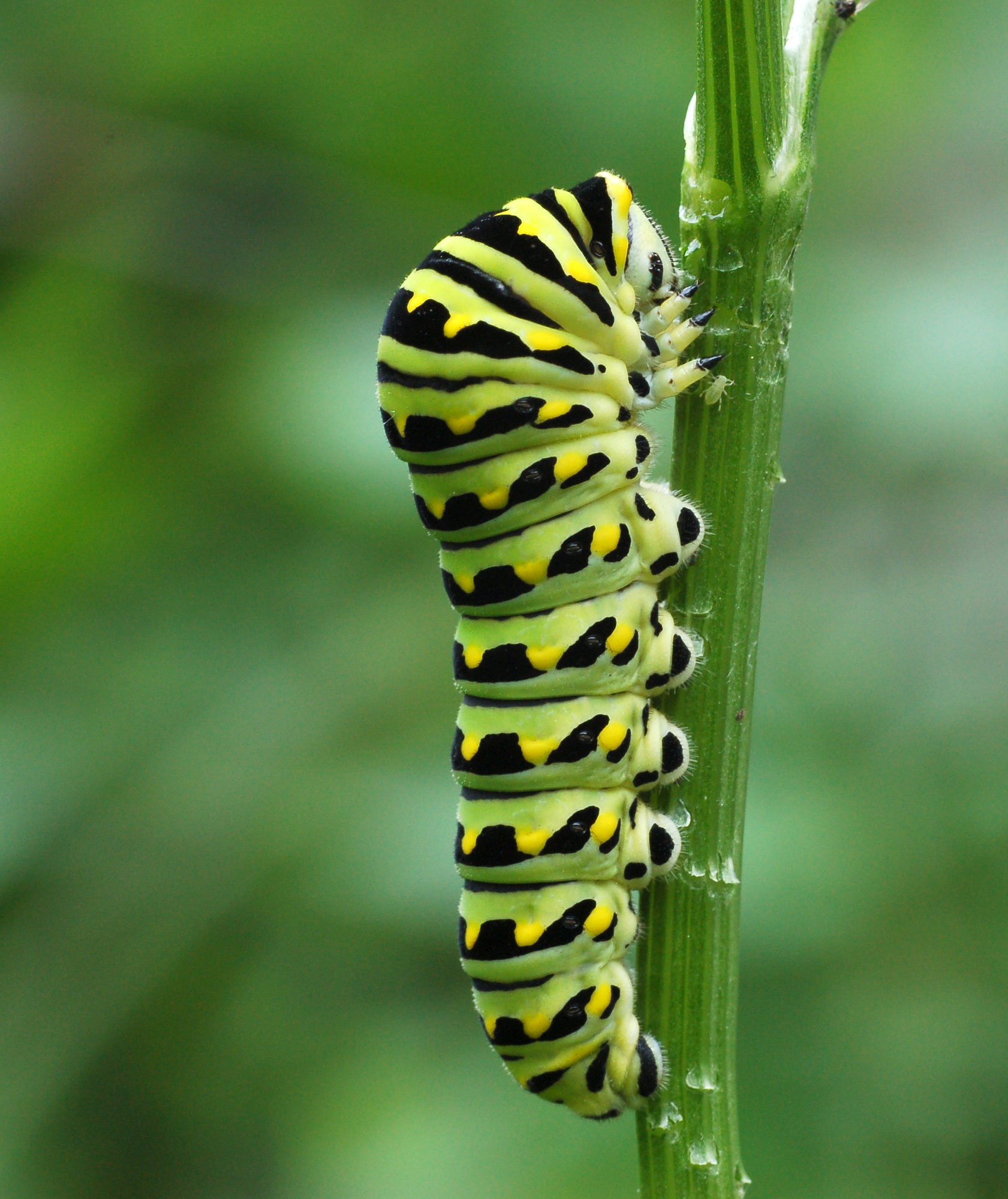
Wild parsley with its feather-like leaves across Illinois is the host wildflower of Black Swallowtail Caterpillars (Papilio polyxenes).
This species goes through considerable appearance changes as it gets from one instar to another.
It starts life as a black caterpillar with contrasting dorsal dots. Its final instar finds this caterpillar in a green color with black bands and yellow dots.
Much of its preference for wild parsley which has earned its nickname of The Parsley Worm changes as it turns into a butterfly.
One of the most vulnerable periods for the species is as a butterfly that has no food source.
3. Eastern Tiger Swallowtail Caterpillar

Eastern Tiger Swallowtail Caterpillars (Papilio glaucus) are known for hiding in host plant leaves.
A large leaf is curled and joined by silk at the top for the caterpillar to hide in until the leaf is eaten.
Multiple hosts are characteristic of this species. This includes magnolia and tulip trees and their leaves the caterpillar eats.
This species goes through considerable changes such as switching from a brown to a green color as it grows.
Large white and black eyespots are seen on the head of the species. These eyespots have a purely defensive role.
4. Silver-spotted Skipper Caterpillar

A colorful caterpillar, the Silver-Spotted Skipper Caterpillar (Epargyreus clarus) is among the largest in Illinois.
This species reaches a length of around 2 inches in its final instar. A wide colorful body is also specific to the species.
Bright yellow coloring is seen across its body. Faint brown lines decorate its sides and dorsum, together with tiny brown dots.
Its head is brown or red-brown, contrasting its bright appearance.
Feeding on vine leaves, the species is among the first caterpillars to eat False Indigobush and Butterfly Pea leaves.
5. Small White Caterpillar

This species (Pieris rapae) starts life as a yellow egg to go through color and appearance changes as it grows as a caterpillar.
Small White Caterpillars are among the serious pests of cabbage. Making their way inside the cabbage, they can eat its leaves, making it commercially unviable.
This caterpillar has a green color with various yellow stripes and marks which change as the species grows.
It can often be found on crops and in gardens. Apart from cabbages, this species can also eat broccoli.
6. Red Admiral Caterpillar

One of the smaller types of caterpillars in the state is The Red Admiral Caterpillar (Vanessa atalanta). It only grows to a length of 1 inch.
The species starts life as a small green egg, barely visible on its host plant leaves.
Stinging Nettle and other types of nettle are its main hosts.
The caterpillar has a black color with black spikes in its initial growth stages.
It brightens but remains brown in its final caterpillar stage when tiny white dots contrast its dark body with its spines.
This caterpillar eventually turns into a orange and black butterfly.
7. Common Buckeye Caterpillar
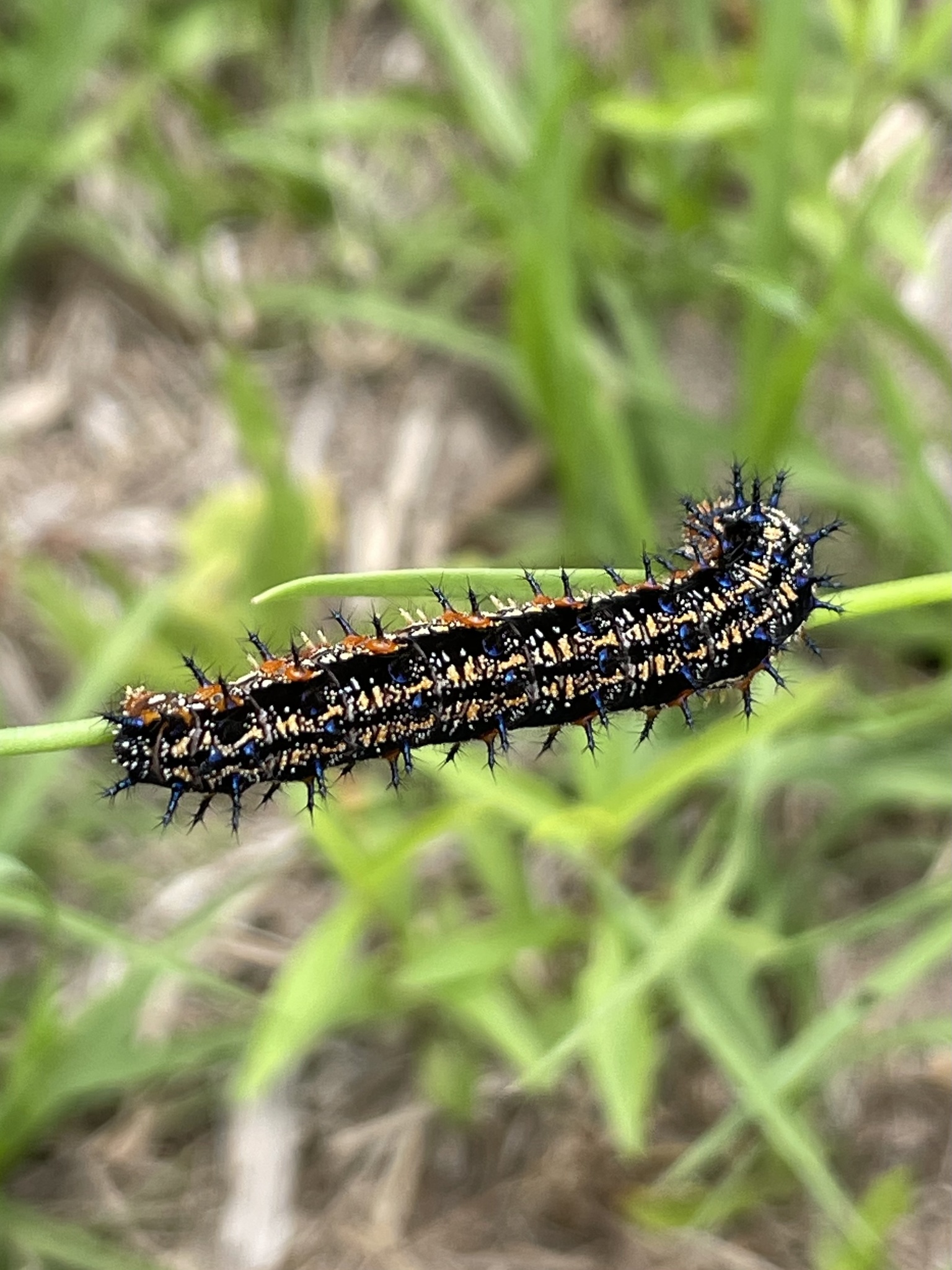
Plantain is one of the broad-leaved host plants of The Common Buckeye Caterpillar (Junonia coenia).
This species has variable coloring, but it generally has a combination of dark colors and spines along its body.
Black and brown alternating stripes along its body are the most specific. Some caterpillars of the species may also show white stripes or interrupted white stripes in between.
A more black-orientated color is also specific to the species. Only tiny white dots contrast its black appearance.
All of these morphs are completed by a series of black spine rows along their dorsum.
8. Painted Lady Caterpillar
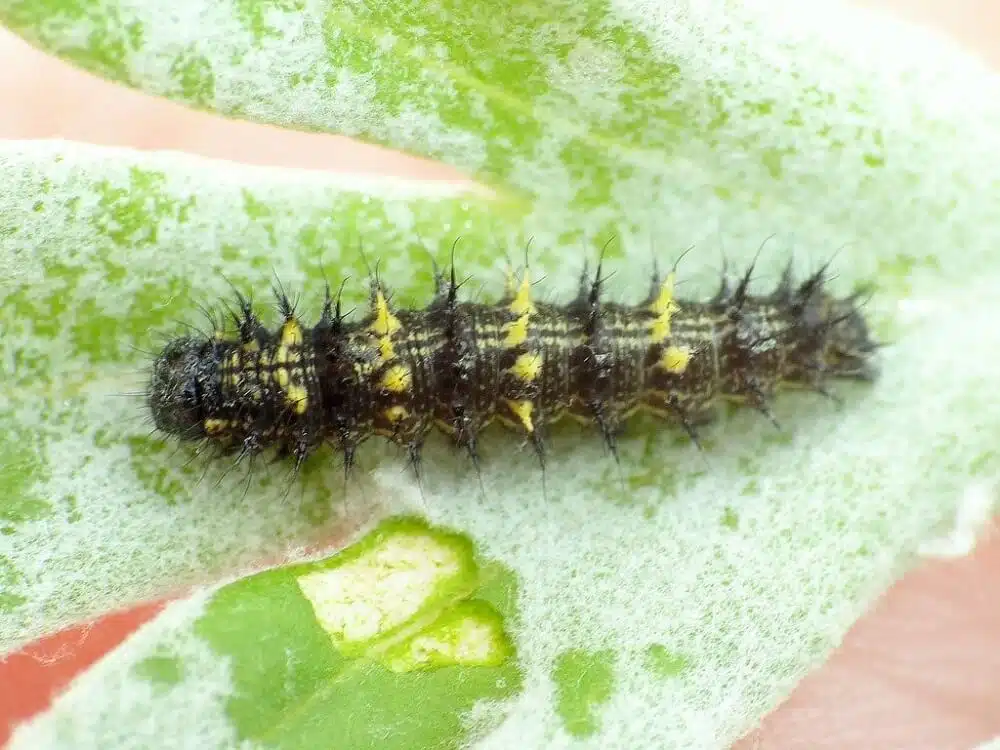
A wide range of hosts is specific to The Painted Lady Caterpillar (Vanessa cardui). This species is among the multiple types of caterpillars that build silk structures on leaves to escape potential predators.
At least a few hundred host species have been documented for these caterpillars, mainly different types of asters.
Plum thistles, plumeless thistles, sunflower, and cottonthisltes are among the hundreds of species this caterpillar lives and feeds on.
This migratory species lives throughout Illinois, with a preference for open fields and marshes.
9. Red-spotted Admiral Caterpillar

Yellow birch is a typical host of Red-spotted Admiral Caterpillar (Limenitis arthemis) in Illinois.
These types of caterpillars may appear twice in the season, with at least one generation going through wintertime hibernation or a growing pause.
Its caterpillars have gray, tan, and brown coloring with prolegs of a similar color combination.
The mottled appearance of the species may make it look similar to bird droppings, a camouflaging trait of the species.
This caterpillar also has dark long antennae and it goes into a pupal stage of around 2 weeks before emerging as a butterfly.
10. Ailanthus Webworm
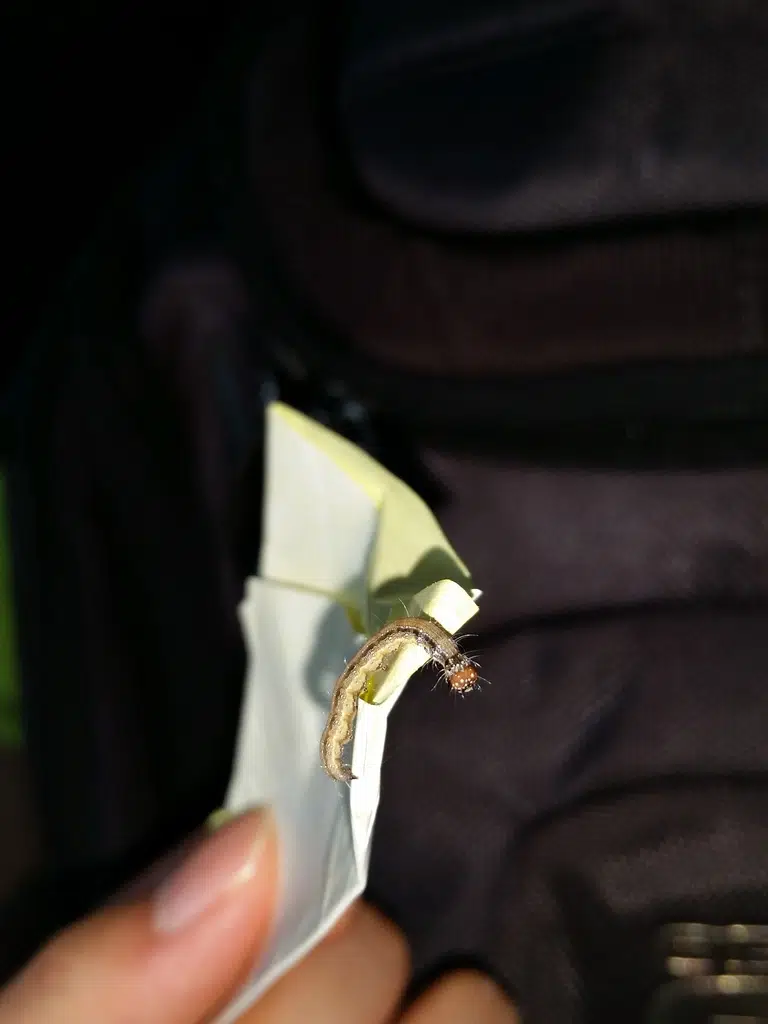
This type of webworm caterpillar (Atteva aurea) moves throughout Illinois sporadically or every year.
Its adaptation to a longer stay in the state is believed to be an adaptation towards cooler climates, as it was once a species feeding on Tree of Heaven invasive trees in the Southeastern US range.
Caterpillars of this family feed on tree leaves and build large silk webs around their leaves. These types of silk structures similar to tents protect them from immediate predators such as wasps.
Different color combinations of brown and black are specific to this species, which may also appear green.
11. Banded Woolly Bear

Banded Woolly Bears (Pyrrharctia isabella) were long believed to be urticant or cause other severe skin conditions due to their sharp spine-like hairs.
These caterpillars may only cause dermatitis, but not more serious skin conditions as these caterpillars aren’t venomous.
They are found around the state and have adapted to overwintering in a larval stage. They enter a growth pause during the winter months.
Brown and black coloring are specific to these caterpillars which have a 13-segment body. All of these segments are covered in spiny brown or black hairs.
12. Hackberry Emperor Caterpillar

A distinct appearance is specific to the Hackberry Emperor Caterpillar (Asterocampa celtis), one of the North America caterpillars with horns.
This species has short brown-black horns on its small head and a green body with specific tiny yellow dots.
Yellow stripes and dots are also specific to its pupal stage, marked by a similar green ground color.
Hackberry Emperor Caterpillars are averagely-sized, reaching a maximum length of around 1.4 inches.
As its name suggests, this is a species that lives on hackberry trees in Illinois.
13. Question Mark Caterpillar
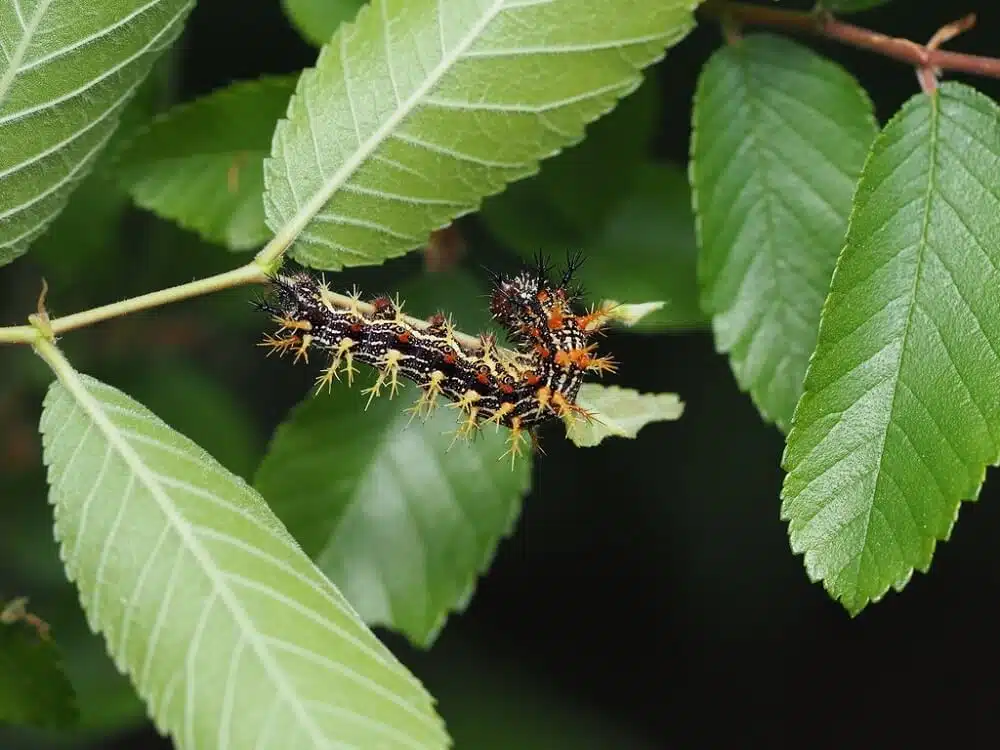
Question Mark Caterpillars (Polygonia interrogationis) may also feed on hackberry leaves but their preferred food is the leaves of elm trees.
These types of caterpillars may reach a length of up to 1.4 inches and are known for their spiny bodies.
A brown to black body is specific to this species which also has yellow stripes along the dorsum.
Some Question Mark caterpillars also have tiny yellow spots. These spots may be easy to spot or difficult to spot also according to the growth stage of the caterpillar.
The spines along the dorsum of the caterpillar are mostly red-brown.
14. Spicebush Swallowtail Caterpillar

High color variation is specific to the Spicebush Swallowtail Caterpillar (Papilio troilus), one of the most common species in Illinois and North America.
Mostly brown, this caterpillar turns green in its later growth stages.
The caterpillar is known for folding a leaf and closing it with a silk thread to hide from predators. It is also known for having 2 large eyespots which perceivably makes it look more dangerous to its potential predators.
The spicebush wildflower found across Eastern states is also the main host of this species.
Deciduous trees and woodlands may also offer alternative hosts for this species.
15. Viceroy Caterpillar

Multiple defensive mechanisms make the Viceroy Caterpillar (Limenitis archippus) unique.
This species absorbs toxins such as salicylic acid from its host tree to become unpalatable to its predators.
The Viceroy Caterpillar is further known for its mimicry of bird droppings, a characteristic it carries further into its pupal stage.
Some of the common areas of the species in the state include habitats close to the water as this is where willow, its main host, grows.
Viceroy caterpillars have brown, white, and black coloring resembling bird droppings on the leaves of their host willow. In most cases, the damages to the host are minimal.
16. Eastern Comma Caterpillar
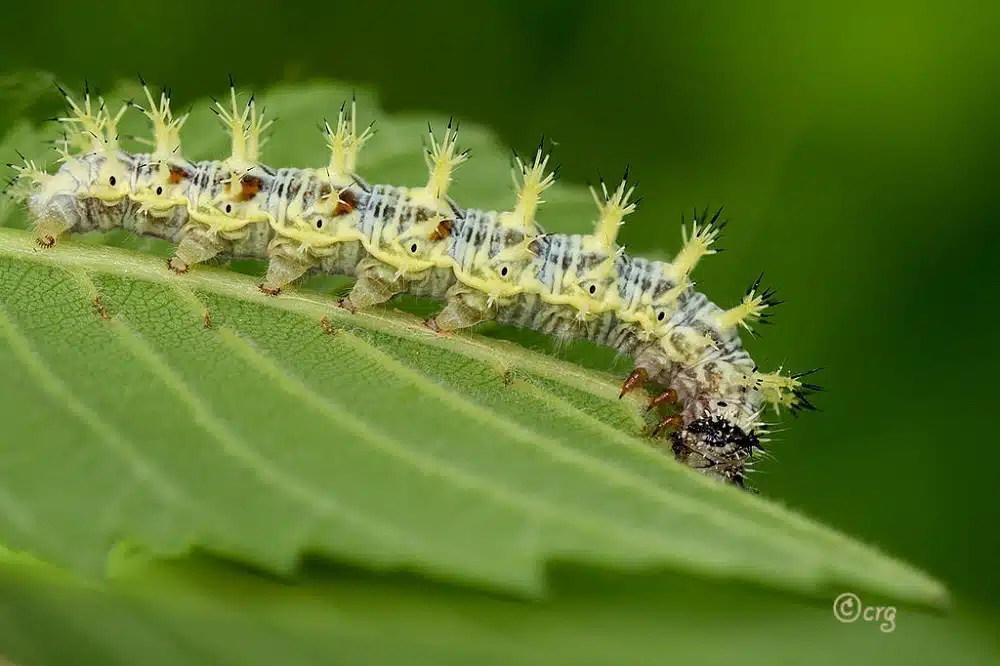
A small to medium-sized body is specific to The Eastern Comma Caterpillar (Polygonia comma), a species found around ditches, woodlands, and open fields.
Its presence around the state is mainly tied to the presence of its hosts, mainly in the nettle family. While rare, this species can also settle on local elm.
The Eastern Comma Caterpillar has a body that may reach 1.2 inches and a dark appearance, in general.
The black color with white or yellow marks and stripes is specific to this caterpillar.
This species also has deterrent spikes on its dorsal side. These are either yellow or white.
17. White-marked Tussock Moth Caterpillar

The White-marked Tussock Moth Caterpillar (Orgyia leucostigma) is one of the species which may defoliate its host trees.
Urban areas where trees such as elm grow in small numbers are at particular risk of defoliation compared to trees found in woodlands or higher numbers.
This species can live on various trees in mixed woodlands, deciduous woodlands, and pine woodlands.
It stands out by having 4 large glands, black tufts, and a contrasting-colored body.
This caterpillar may be spotted along different types of trees in the state. They are also present on oak and willow, among a wider range of pine such as fir.
18. Polyphemus Moth Caterpillar

Polyphemus Moth Caterpillars (Antheraea polyphemus) appear in 2 generations per year. Dominated by a green color through their growth stages, they change their size and appearance as they grow.
These are also some of the largest caterpillars in Illinois. A grown Polyphemus Moth Caterpillar reaches a length of up to 4 inches.
The large size of the species also means it can be dangerous to its hosts such as elm and birch.
Alternating spots on its green body appear on its dorsum as it grows. Initial yellow spots from its early growth stages turn to yellow spots in its later stages.
19. Milkweed Tussock Moth Caterpillar

As its name implies, this caterpillar species (Euchaetes egle) feeds on milkweed. It also feeds on other host plants such as dogbane, but to a lesser extent.
Milkweed Tussock Moth Caterpillars are one of the smaller species in the state, with an expected maximum size of 1.3 inches.
This caterpillar stands out with long hairs that cover its body.
An almost hairless body is specific to the first instar Milkweed Tussock Moth Caterpillar. By its final instar, this species has a body covered in black, white, and orange-brown hairs.
This species is known to absorb the organic compounds in milkweed to become untasteful to its predators.
20. Yellow Woolly Bear

Ground cover is the type of host wildflowers and plants the Yellow Woolly Bear Caterpillar (Spilosoma virginica) feeds on.
This is a species known for its uniform coloring, typically yellow or bright yellow.
Crops can be impacted by high numbers of Yellow Woolly Bears. These caterpillars feed in large amounts and they can defoliate crops in the case of uncontrolled outbreaks.
The species isn’t as dangerous in Illinois as in other states where it appears in several broods per year.
21. Pipevine Swallowtail Caterpillar

Pipevine Swallowtail caterpillars (Battus philenor) are named after their pipevine host plants.
This is a species with high toxicity levels as it extracts the organic compounds of its hosts, which are also toxic.
Pipevine is highly toxic to a high number of animals. It even kills insects and other butterflies that try to feed on it.
Pipevine Swallowtail Caterpillars are immune to the toxic nature of their hosts and even absorb the toxins to make them distasteful to predators.
Green Anoles are among the few species which can eat the Pipevine Swallowtail Caterpillar.
22. Eastern Giant Swallowtail Caterpillar

Mimicry of bird droppings is specific to The Eastern Giant Swallowtail Caterpillar (Heraclides cresphontes).
White, brown, and tan colors are seen across its body.
This is a species that feeds on the leaves of its host trees but which is found in different areas of the tree according to its age.
Younger caterpillars are less experienced and sit on the late instar caterpillars and move up the stems.
23. American Lady Caterpillar

Sweet Everlasting and Plantain are a few of the common host plants of The American Lady Caterpillar (Vanessa virginiensis).
Roadsides and meadows are places where these plants grow.
This species is characterized by a black body with a banded appearance. Groups of thin yellow, golden, or gray bands are specific to the body of this species.
The American Lady Caterpillar also features larger white dots and short black spines.
24. Wild Indigo Duskywing Caterpillar

A bi-colored appearance is specific to the Wild Indigo Duskywing Caterpillar (Erynnis baptisiae).
Most of its body is green. A bright green color with white spots or lines is characteristic of this species.
Its head is mostly dark brown.
The color of its head is further carried into adulthood as various shades of brown are spotted on the body of the Wild Indigo Duskywing Butterfly.
25. Great Spangled Fritillary Caterpillar
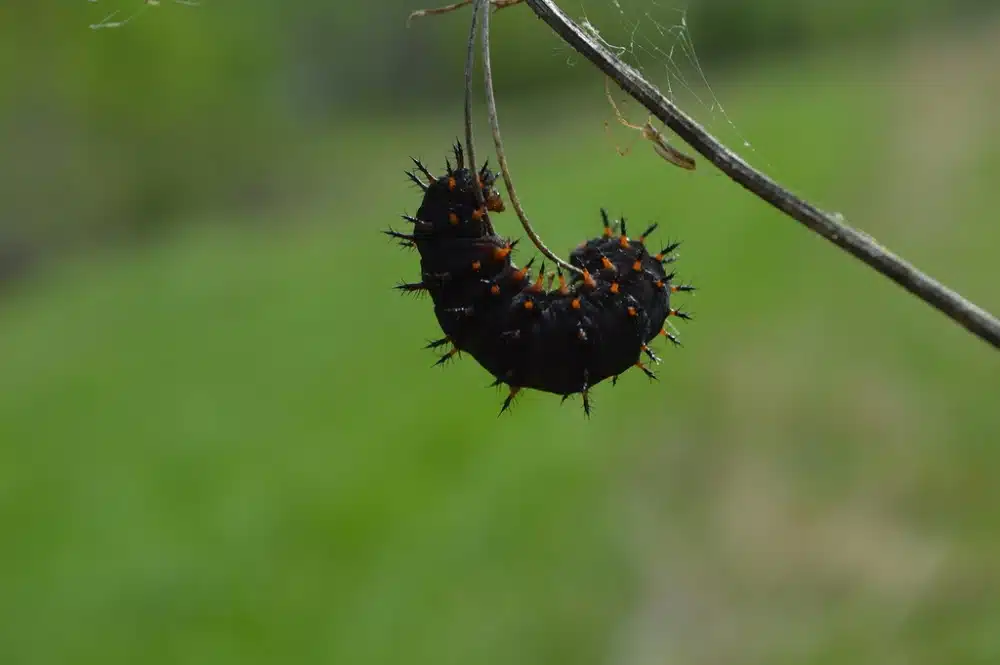
Wildflowers such as violets are the hosts of The Great Spangled Fritillary Caterpillar (Speyeria cybele).
This species doesn’t eat tree leaves like most other caterpillars in Illinois.
A dark appearance best describes this caterpillar. It has a black body with either orange or brown spots and a few short dorsal tubercles.
The species grows longer black spines into its latest instars.
26. Corn Earworm

Corn Earworm (Helicoverpa zea) is the most damaging type of caterpillar to crops in Illinois.
A wide range of crops can be invaded by the Corn Earworm Caterpillar.
It was once believed only tomato and corn crops could be invaded by this species. This family of caterpillars also invades cucumber, pea, pepper, and many other types of crops.
A mottled green and light green appearance is specific to the species.
27. Snowberry Clearwing Caterpillar

Found throughout the state, this type of caterpillar (Hemaris diffinis) feeds on snowberry and honeysuckle. On occasion, it may also feed on other wildflowers as it has been spotted on dogbane.
This species has an initial brown color with white spots. It later turns green.
Small lateral eyespots are seen on the species in its later growth stages. Its prolegs are also green.
28. American Dagger Caterpillar

This type of caterpillar (Acronicta americana) has a hairy body. Long yellow hairs on the species can trigger skin-level reactions when touched.
Toxins are stored in these hairs and it’s best to stay away from the species.
Oak and elm leaves are among their typical foods.
American Dagger Caterpillars are some of the largest caterpillars in Illinois. They regularly reach a size of 2 inches.
29. Silvery Checkerspot Caterpillar

Areas around water are ideal places for The Silvery Checkerspot Caterpillar (Chlosyne nycteis).
This species is found in moist areas around water and has a dark appearance.
Its body is almost completely black. A couple of dark brown stripes are seen on its dorsum.
Black spike-like hairs also grow on its back towards its later growth stages.
The species is less common in Illinois and highly common in Southern states where it appears in multiple broods.
30. American Snout Caterpillar

The humpbacked-looking American Snout Caterpillar (Libytheana carinenta) has a mostly green color.
A bright yellow lateral stripe is seen on the species. Tiny and barely visible yellow spots cover its green body.
It can sometimes be found around the state, depending on the migration movements of the species. Some Southern groups of American Snouts move North when their habitat is overcrowded.
31. Cloudless Sulphur Caterpillar

Only stray caterpillars of this species (Phoebis sennae) may be found in Illinois, particularly in the Southern part of the state.
The species feeds on various pea-family wildflowers and it may occasionally end up in Illinois as it migrates for food.
The green color is first specific to this caterpillar which also turns yellow and black as it grows.
32. Hummingbird Clearwing Caterpillar
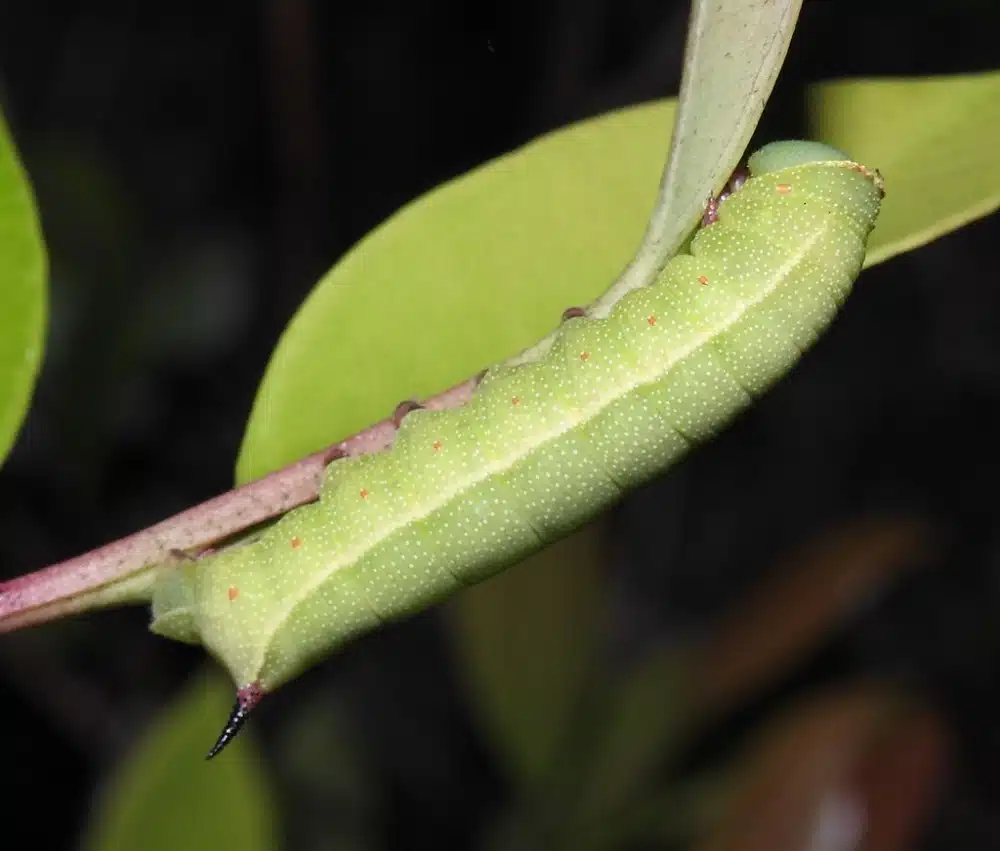
Dogbane, honeysuckle, and cherry trees are the main hosts of the occasional caterpillar.
This species (Hemaris thysbe) has a green color with or without spots, depending on its growth stage.
Caterpillars of the species dig into the ground for their pupal stage. They remain hidden in the ground until spring arrives.
33. North American Luna Moth Caterpillar

A green body with short green tubercles is specific to the emerging North American Luna Moth Caterpillar (Actias luna).
As it grows, it starts to change its appearance to a mostly green body.
This species becomes dorsally red and ventrally green in its 4th and 5th instars. Dark red spots are also visible on the caterpillar in its later growth stages.
Birch and American Sweet Gum are among the multiple host trees where the species can be spotted on.
34. Yellow-collared Scape Moth Caterpillar
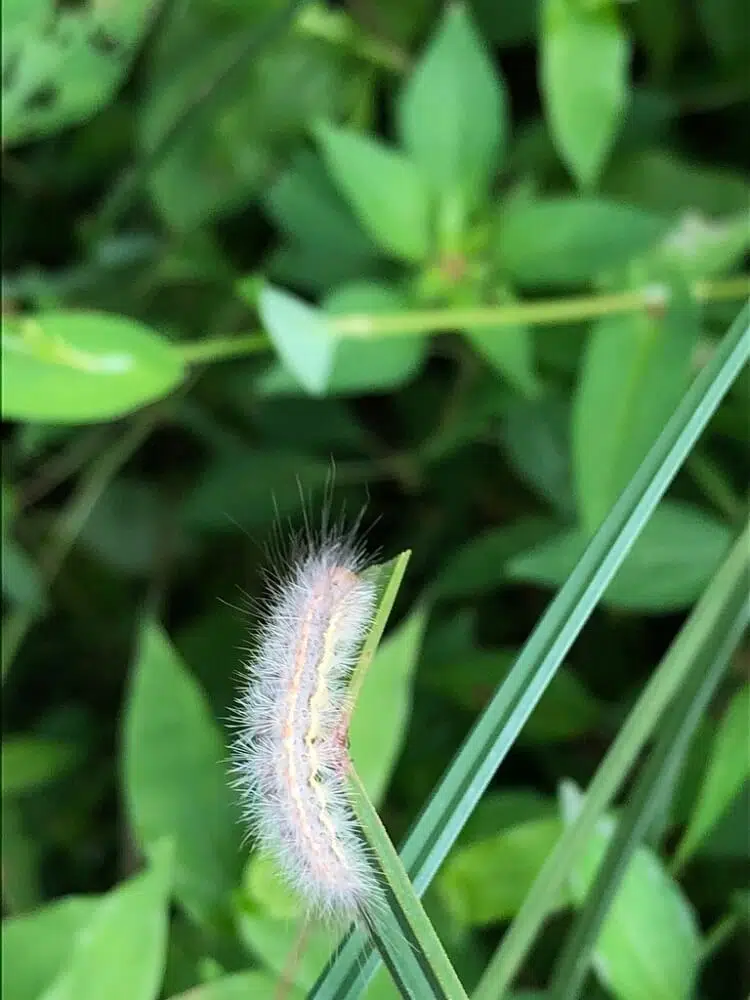
Plants such as sedges are among the typical hosts of The Yellow-collared Scape Moth Caterpillar (Cisseps fulvicollis).
Occasionally spotted in the state, this caterpillar also changes its appearance as it grows.
It has a white color with white hairs in its initial growth stages. While it still has hairs in its later growth stages, the caterpillar becomes almost completely black.
Intermediate growth stages can be marked by brown or yellow banding across a dark body.